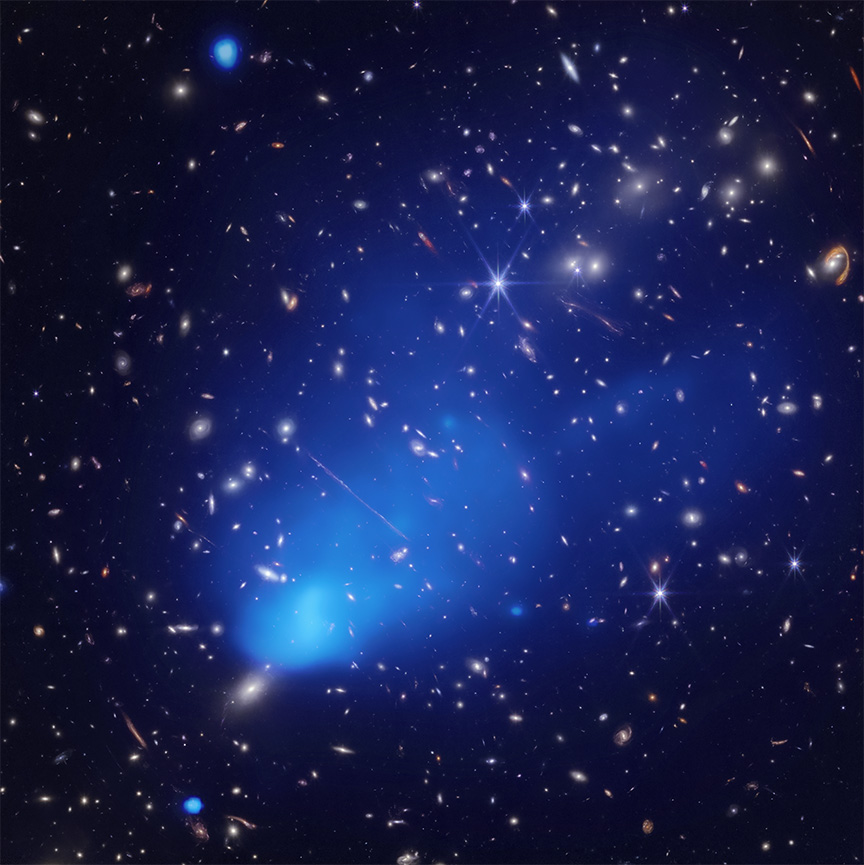
 Credit: X-ray: NASA/CXC/Rutgers/J. Hughes et al.; Infrared: NASA/ESA/CSA, J.M. Diego (IFCA), B.Frye (Univ. of Arizona), P.Kamieneski, T.Carleton & R.Windhorst (ASU);
Image processing: X-ray: L. Frattare; J. Major, K.Arcand (SAO). Infrared: A.Pagan (STScI), J.Summers (ASU), J.C.J.D'Silva (UWA), A.M.Koekemoer (STScI), A.Robotham (UWA), R.Windhorst (ASU)
Credit: X-ray: NASA/CXC/Rutgers/J. Hughes et al.; Infrared: NASA/ESA/CSA, J.M. Diego (IFCA), B.Frye (Univ. of Arizona), P.Kamieneski, T.Carleton & R.Windhorst (ASU);
Image processing: X-ray: L. Frattare; J. Major, K.Arcand (SAO). Infrared: A.Pagan (STScI), J.Summers (ASU), J.C.J.D'Silva (UWA), A.M.Koekemoer (STScI), A.Robotham (UWA), R.Windhorst (ASU)
Large-Scale Weight Gain
The largely-empty Universe can be a crowded place sometimes. Entire clusters of galaxies, whizzing by each other through the dark alleyways of space, will sometimes smash together, and, surprisingly, a superior force may be driven out from the center of the engagement. That seems to be what's happening in the case of "El Gordo", an object formed as one large galaxy cluster collides with a smaller one at a speed of nearly 10 million miles per hour. El Gordo is an astounding object - it is the most massive, the hottest, and most luminous in X-rays of any known galaxy cluster at its distance or beyond. A new study combining infrared images from JWST and X-ray images from the Chandra X-ray Observatory details the "dark" and "light" side of the mass of El Gordo. The Chandra X-ray image (the blue diffuse patch near the center of the image) shows that the X-ray emission produces a "wake" extending from the lower left to the upper right in the image, indicating how the hot intracluster gas is swept back by the collision. The deep JWST image details the number of galaxies in the field, some of which are cluster members and some of which are background or foreground galaxies. The sensitivity of the JWST image also reveals dozens of arc-like structures. These structures are the distorted, gravitationally lensed image produced when light from background galaxies shines through the distorted spacetime produced by the enormous mass of El Gordo. Analysis of these arcs suggests that El Gordo has a mass in excess of a quadrillion times the mass of the sun, thousands of times the mass of the Milky Way, and near the theoretical limit for galaxy clusters.
Published: August 14, 2023
<
HEA Dictionary ● Archive
● Search HEAPOW
● Other Languages
● HEAPOW on Facebook
● Download all Images
● Education ● HEAD
>

Each week the HEASARC
brings you new, exciting and beautiful images from X-ray and Gamma ray
astronomy. Check back each week and be sure to check out the HEAPOW archive!
Page Author: Dr. Michael F. Corcoran
Last modified Monday, 26-Feb-2024 17:35:01 EST


